Instructor Planning Guide
Activities
What activities are associated with this chapter?
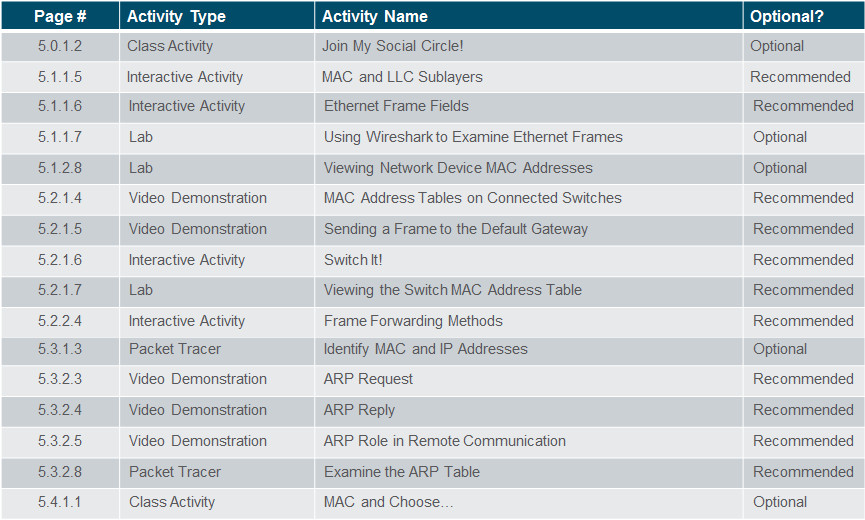
Assessment
Students should complete Chapter 5, “Assessment” after completing Chapter 5.
Quizzes, labs, Packet Tracers and other activities can be used to informally assess student progress.
Sections & Objectives
5.1 Ethernet Protocol
♦ Explain the operation of Ethernet.
♦ Explain how the Ethernet sublayers are related to the frame fields.
♦ Describe the Ethernet MAC address
5.2 LAN Switches
♦ Explain how a switch operates.
♦ Explain how a switch builds its MAC address table and forwards frames.
♦ Describe switch forwarding methods and port settings available on Layer 2 switch ports.
5.3 Address Resolution Protocol
♦ Explain how the address resolution protocol enables communication on a network.
♦ Compare the roles of the MAC address and the IP address.
♦ Describe the purpose of ARP.
♦ Explain how ARP requests impact network and host performance.
Chapter 5: Ethernet
5.1 – Ethernet Protocol
5.1.1 – Ethernet Frame
5.1.1.1 – Ethernet Encapsulation
Ethernet is the most widely used LAN technology today.
♦ Defined in the IEEE 802.2 and 802.3 standards.
♦ It supports data bandwidths of 10 Mb/s, 100 Mb/s, 1000 Mb/s (1 Gb/s), 10,000 Mb/s (10 Gb/s), 40,000 Mb/s (40 Gb/s), and 100,000 Mb/s (100 Gb/s).
Ethernet operates in the data link layer and the physical layer.
Ethernet relies on the two separate sublayers of the data link layer to operate, the Logical Link Control (LLC) and the MAC sublayers.
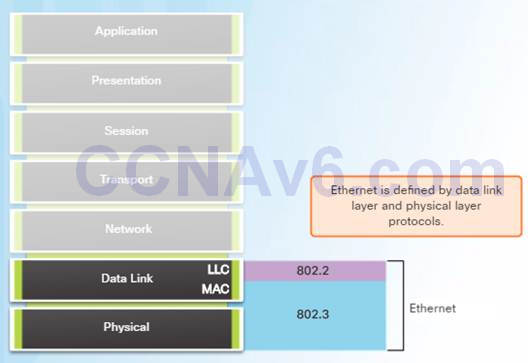
The Ethernet LLC sublayer handles the communication between the upper layers and the lower layers. It is implemented in software, and its implementation is independent of the hardware.
The MAC sublayer constitutes the lower sublayer of the data link layer. MAC is implemented by hardware, typically in the computer NIC.
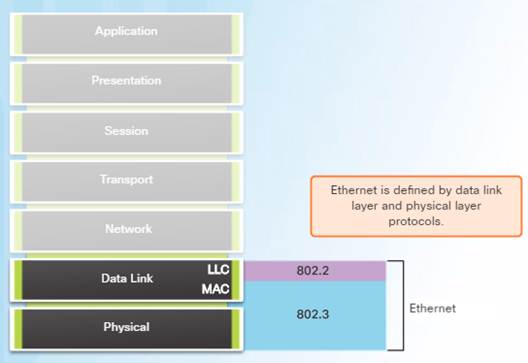
5.1.1.2 – MAC Sublayer
The MAC sublayer has two primary responsibilities:
♦ Data encapsulation
♦ Media access control
Data encapsulation provides three primary functions:
♦ Frame delimiting
♦ Addressing
♦ Error detection
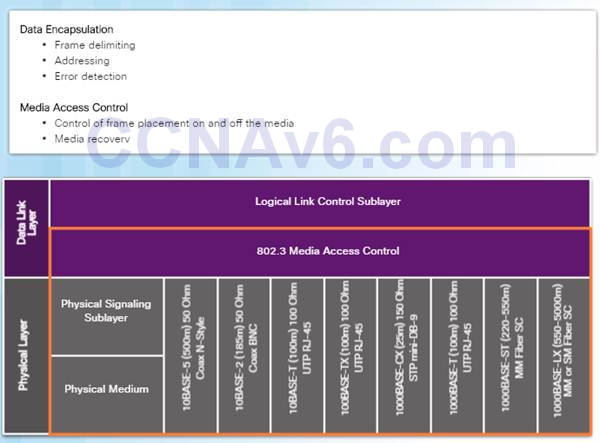
Media access control is responsible for the placement of frames on the media and the removal of frames from the media. This sublayer communicates directly with the physical layer.
5.1.1.3 – Ethernet Evolution
Since 1973, Ethernet standards have evolved specifying faster and more flexible versions of the technology.
Early versions of Ethernet were relatively slow at 10 Mbps.
The latest versions of Ethernet operate at 10 Gigabits per second and faster.
5.1.1.4 – Ethernet Frame Fields
The minimum Ethernet frame size from Destination MAC address to FCS is 64 bytes and the maximum is 1518 bytes.

Frames less than 64 bytes are called a “collision fragment” or “runt frame” and are automatically discarded by receiving stations. Frames greater than 1500 bytes of data are considered “jumbo” or “baby giant frames”.
If the size of a transmitted frame is less than the minimum or greater than the maximum, the receiving device drops the frame.
5.1.1.7 – Lab – Using Wireshark to Examine Ethernet Frames
5.1.1.7 Lab – Using Wireshark to Examine Ethernet Frames
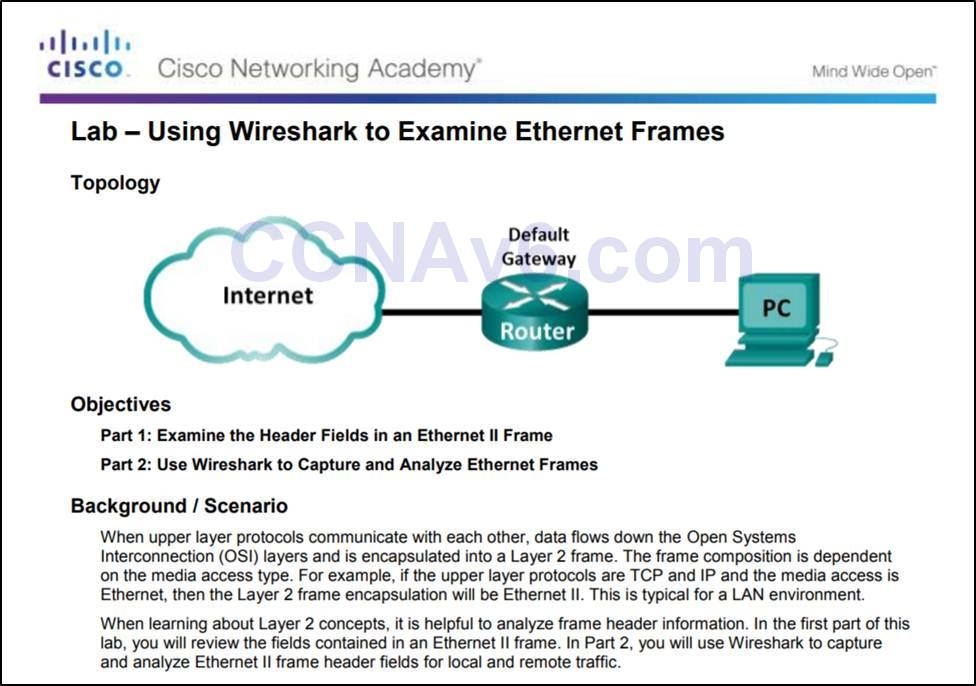
5.1.2 – Ethernet MAC Addresses
5.1.2.1 – MAC Addresses and Hexadecimal
An Ethernet MAC address is a 48-bit binary value expressed as 12 hexadecimal digits (4 bits per hexadecimal digit).
Hexadecimal is used to represent Ethernet MAC addresses and IP Version 6 addresses.
♦ Hexadecimal is a base sixteen system using the numbers 0 to 9 and the letters A to F.
♦ It is easier to express a value as a single hexadecimal digit than as four binary bits.
♦ Hexadecimal is usually represented in text by the value preceded by 0x (E.g., 0x73).
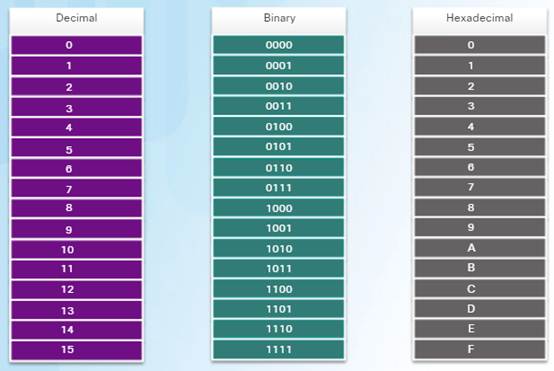
Convert the decimal or hexadecimal value to binary, and then to convert the binary value to either decimal or hexadecimal as needed.
5.1.2.2 – MAC Addresses: Ethernet Identity
MAC addresses were created to identify the actual source and destination.
♦ The MAC address rules are established by IEEE.
♦ The IEEE assigns the vendor a 3-byte (24-bit) code, called the Organizationally Unique Identifier (OUI).
IEEE requires a vendor to follow two simple rules:
♦ All MAC addresses assigned to a NIC or other Ethernet device must use that vendor’s assigned OUI as the first 3 bytes.
♦ All MAC addresses with the same OUI must be assigned a unique value in the last 3 bytes.
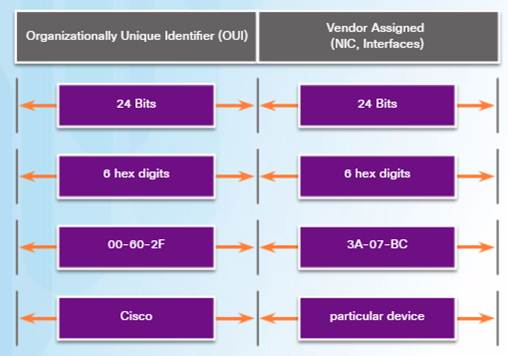
5.1.2.3 – Frame Processing
The MAC address is often referred to as a burned-in address (BIA) meaning the address is encoded into the ROM chip permanently. When the computer starts up, the first thing the NIC does is copy the MAC address from ROM into RAM.
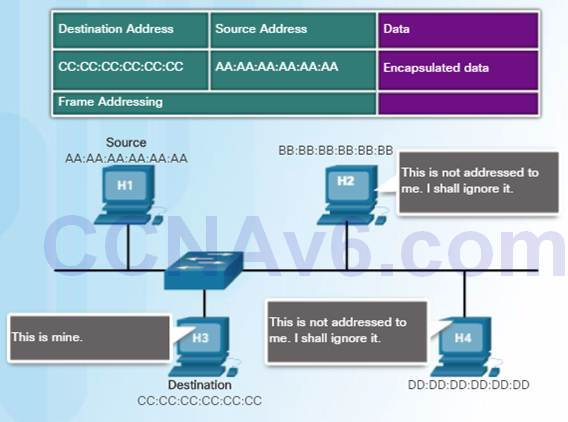
When a device is forwarding a message to an Ethernet network, it attaches header information to the frame.
The header information contains the source and destination MAC address.
5.1.2.4 – MAC Address Representations
Use the ipconfig /all command on a Windows host to identify the MAC address of an Ethernet adapter. On a MAC or Linux host, the ifconfig command is used.
Depending on the device and the operating system, you will see various representations of MAC addresses.
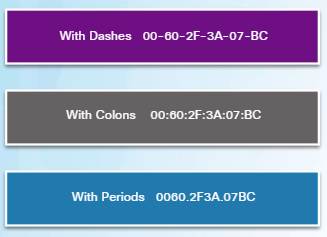
5.1.2.5 – Unicast MAC Address
A unicast MAC address is the unique address used when a frame is sent from a single transmitting device to a single destination device.
For a unicast packet to be sent and received, a destination IP address must be in the IP packet header and a corresponding destination MAC address must also be present in the Ethernet frame header.
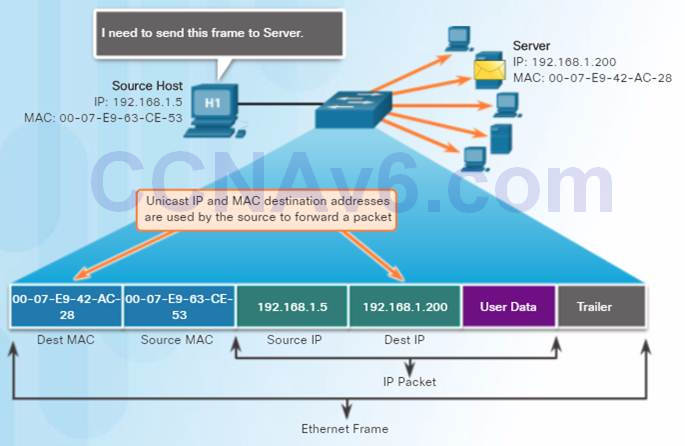
5.1.2.6 – Broadcast MAC Address
Many network protocols, such as DHCP and ARP, use broadcasts.
A broadcast packet contains a destination IPv4 address that has all ones (1s) in the host portion indicating that all hosts on that local network will receive and process the packet.
When the IPv4 broadcast packet is encapsulated in the Ethernet frame, the destination MAC address is the broadcast MAC address of FF-FF-FF-FF-FF-FF in hexadecimal (48 ones in binary).
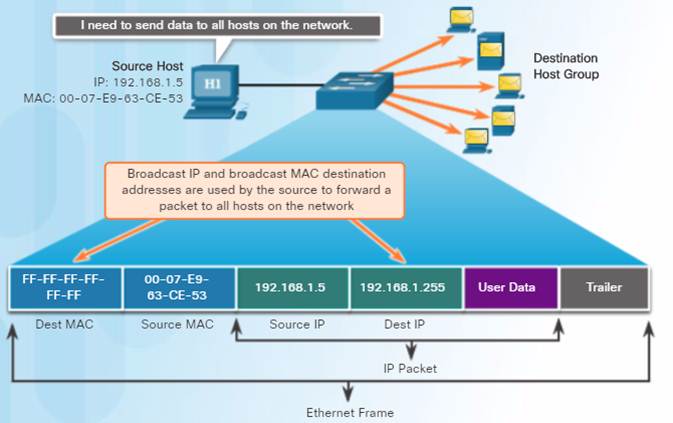
5.1.2.7 –Multicast MAC Address
Multicast addresses allow a source device to send a packet to a group of devices.
♦ Devices in a multicast group are assigned a multicast group IP address in the range of 224.0.0.0 to 239.255.255.255 (IPv6 multicast addresses begin with FF00::/8).
♦ The multicast IP address requires a corresponding multicast MAC address that begins with 01-00-5E in hexadecimal.
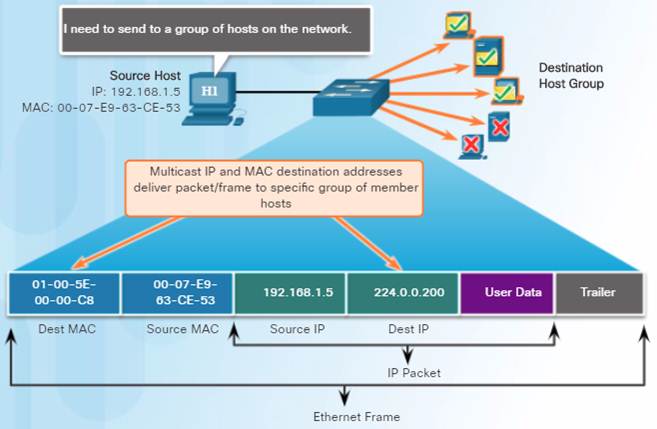
5.1.2.8 – Lab – Viewing Network Device MAC Addresses
5.1.2.8 Lab – Viewing Network Device MAC Addresses
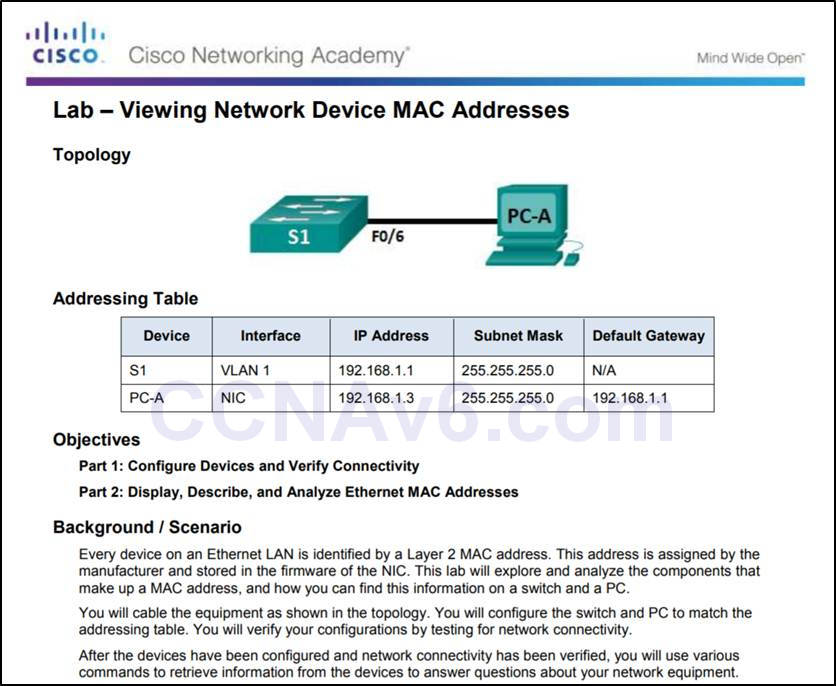
5.2 – LAN Switches
5.2.1 – The MAC Address Table
5.2.1.1 – Switch Fundamentals
A Layer 2 Ethernet switch makes its forwarding decisions based only on the Layer 2 Ethernet MAC addresses.
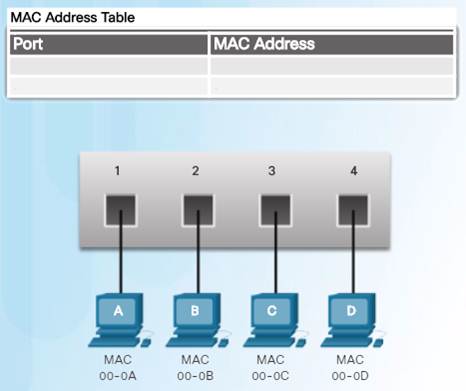
A switch that is powered on, will have an empty MAC address table as it has not yet learned the MAC addresses for the four attached PCs.
Note: The MAC address table is sometimes referred to as a content addressable memory (CAM) table.
5.2.1.2 – Learning MAC Addresses
The switch dynamically builds the MAC address table. The process to learn the Source MAC Address is:
Switches examine all incoming frames for new source MAC address information to learn.
If the source MAC address is unknown, it is added to the table along with the port number.
If the source MAC address does exist, the switch updates the refresh timer for that entry.
By default, most Ethernet switches keep an entry in the table for 5 minutes.
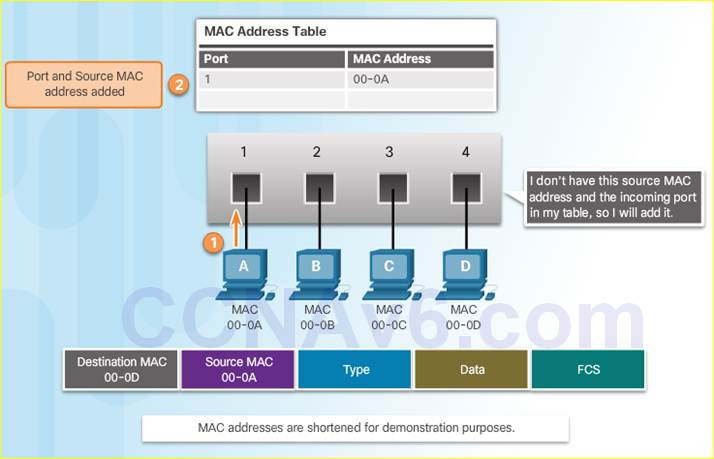
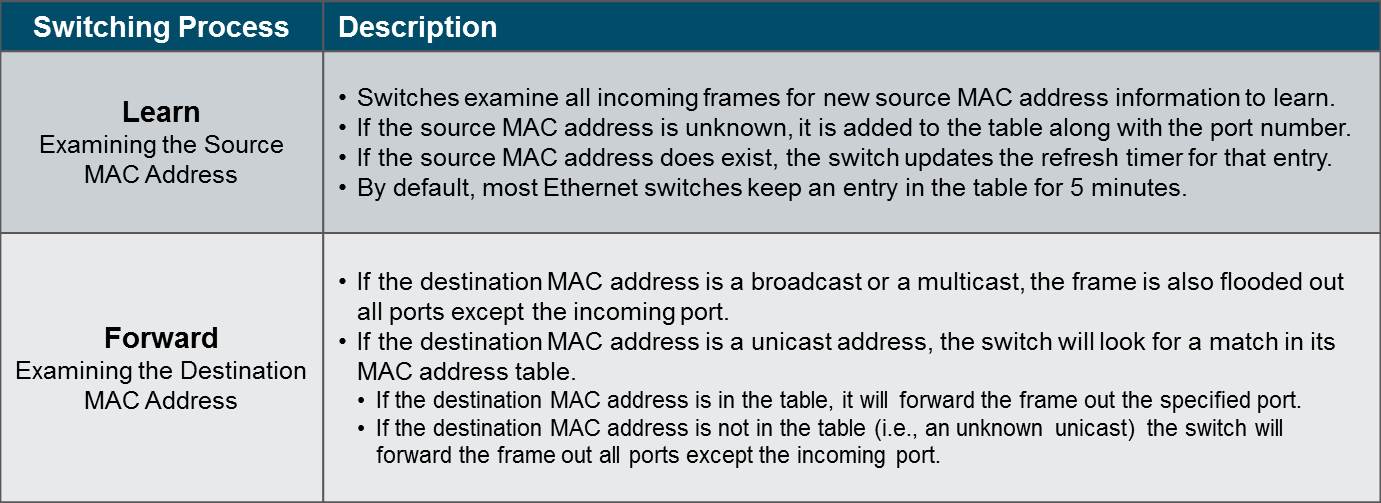
The process to forward the Destination MAC Address is:
♦ If the destination MAC address is a broadcast or a multicast, the frame is also flooded out all ports except the incoming port.
♦ If the destination MAC address is a unicast address, the switch will look for a match in its MAC address table.
♦ If the destination MAC address is in the table, it will forward the frame out the specified port.
♦ If the destination MAC address is not in the table (i.e., an unknown unicast) the switch will forward the frame out all ports except the incoming port.
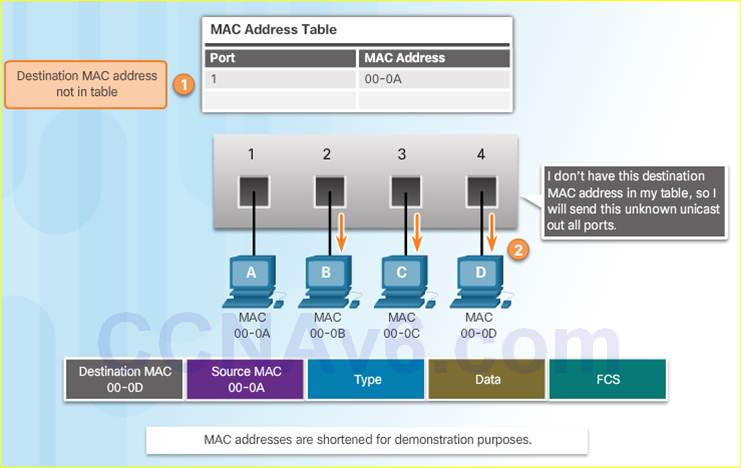
5.2.1.3 – Filtering Frames
As a switch receives frames from different devices, it is able to populate its MAC address table by examining the source MAC address of every frame.
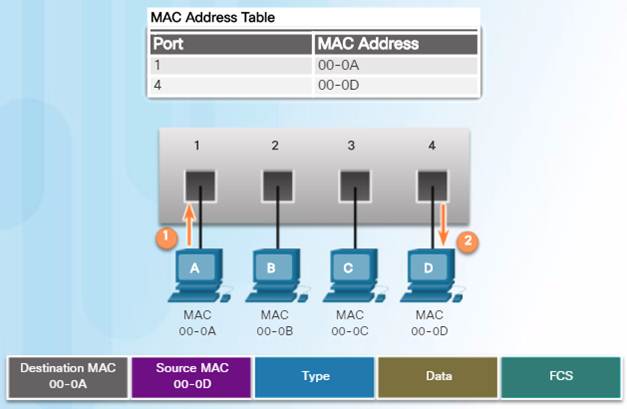
When the switch’s MAC address table contains the destination MAC address, it is able to filter the frame and forward out a single port.
5.2.1.4 – Video Demonstration – MAC Address Tables on Connected Switches
The switch receives the Ethernet frame, examines the source MAC address and notices that this MAC address is not in its MAC address table, so it adds the MAC address and the incoming port number.
Next, the switch examines the destination MAC address and notices that this MAC address is not in its table, so it floods it out all ports.
The computer receives the Ethernet frame, examines the destination MAC address against its own MAC address, and notices that that is a match and receives the rest of the frame.
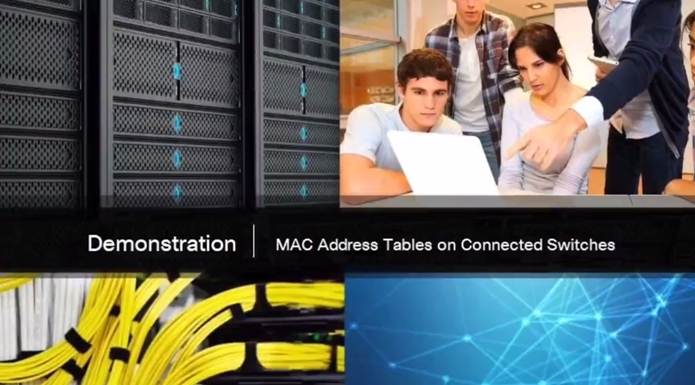
5.2.1.5 – Video Demonstration – Sending a Frame to the Default Gateway
The computer is going to send a packet to the Internet, because the destination IP address is in on another network. In this case, the source MAC address is that of the sending computer. The destination MAC address is that of the router of 00-0D.
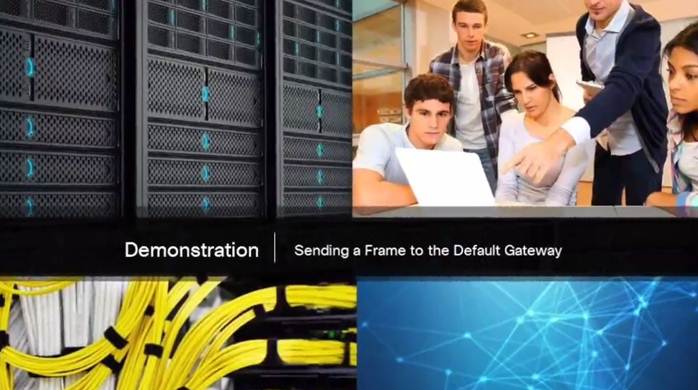
5.2.1.7 –Lab – Viewing the Switch MAC Address Table
5.2.1.7 Lab – Viewing the Switch MAC Address Table

5.2.2 – Switch Forwarding Methods
5.2.2.1 – Frame Forwarding Methods on Cisco Switches
Switches use one of the following forwarding methods for switching data between network ports:
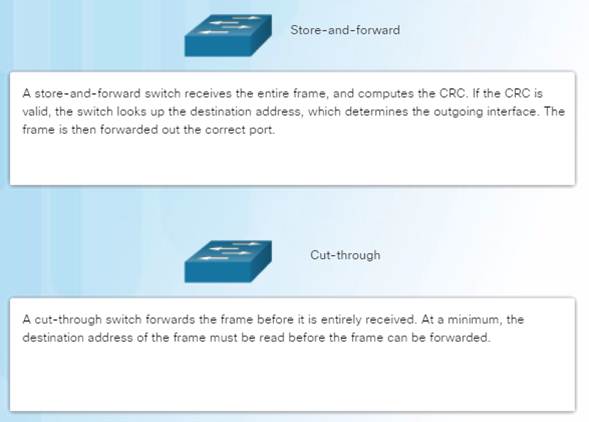
5.2.2.2 – Cut-Through Switching
In cut-through switching, the switch buffers just enough of the frame to read the destination MAC address so that it can determine to which port to forward the data. The switch does not perform any error checking on the frame.
There are two variants of cut-through switching:
♦ Fast-forward switching offers the lowest level of latency. The switch immediately forwards a packet after reading the destination address. This is the most typical form of cut-through switching.
♦ Fragment-free switching, in which the switch stores the first 64 bytes of the frame before forwarding. It is a compromise between store-and-forward and fast-forward switching.
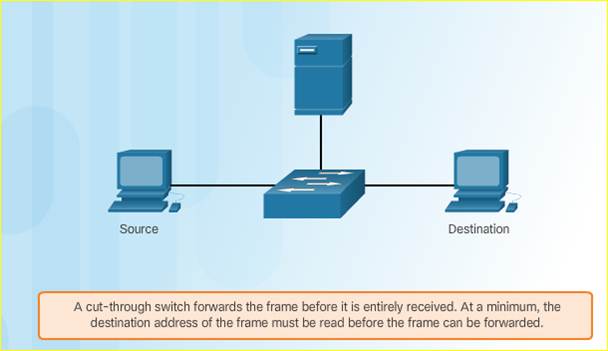
5.2.2.3 – Memory Buffering on Switches
An Ethernet switch may use a memory buffering technique to store frames before forwarding them. Buffering may also be used when the destination port is busy due to congestion and the switch stores the frame until it can be transmitted.
There are two types of memory buffering techniques:

5.2.3 – Switch Port Settings
5.2.3.1 – Duplex and Speed Settings
There are two types of duplex settings used for communications on an Ethernet network:
♦ Full-duplex – Both ends of the connection can send and receive simultaneously.
♦ Half-duplex – Only one end of the connection can send at a time.
Most devices use autonegotiation which enables two devices to automatically exchange information about speed and duplex capabilities and choose the highest performance mode.
Duplex mismatch is a common cause of performance issues with Ethernet links. It occurs when one port on the link operates at half-duplex while the other port operates at full-duplex.

5.2.3.2 – Auto-MDIX
Connections between specific devices such as switch-to-switch, switch-to-router, switch-to-host, and router-to-host devices, once required the use of specific cable types (crossover or straight-through).
Most switch devices now support the automatic medium-dependent interface crossover (auto-MDIX) feature. This is enabled by default on switches since IOS 12.2(18)SE.

When enabled using the mdix auto interface configuration command, the switch detects the type of cable attached to the port, and configures the interfaces accordingly.
5.3 – Address Resolution Protocol
5.3.1 – MAC and IP
5.3.1.1 – Destination on Same Network
There are two primary addresses assigned to a device on an Ethernet LAN:
♦ Physical address (the Ethernet MAC address)
♦ Logical address (the IP address)
As an example, PC-A sends an IP packet to the file server on the same network. The Layer 2 Ethernet frame contains:
♦ Destination MAC address
♦ Source MAC address
The Layer 3 IP packet contains:
♦ Source IP address
♦ Destination IP address
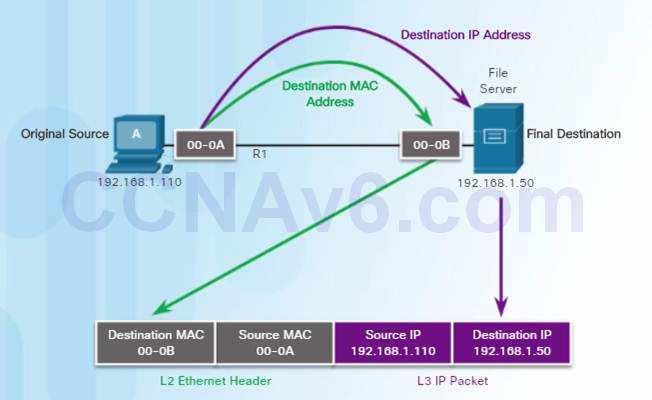
5.3.1.2 – Destination on Remote Network
When the destination IP address is on a remote network, the destination MAC address will be the address of the host’s default gateway.
In the figure, PC-A is sending an IP packet to a web server on a remote network.
♦ The destination IP address is that of the File Server.
♦ The destination MAC address is that of Ethernet interface of R1.
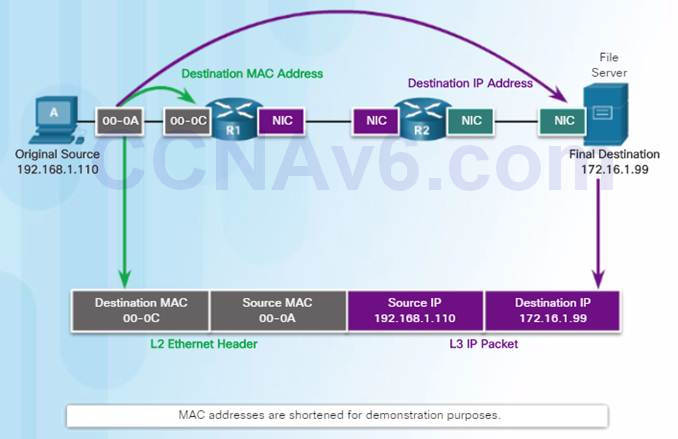
5.3.1.3 – Packet Tracer – Identify MAC and IP Addresses
5.3.1.3 Packet Tracer – Identify MAC and IP Addresses
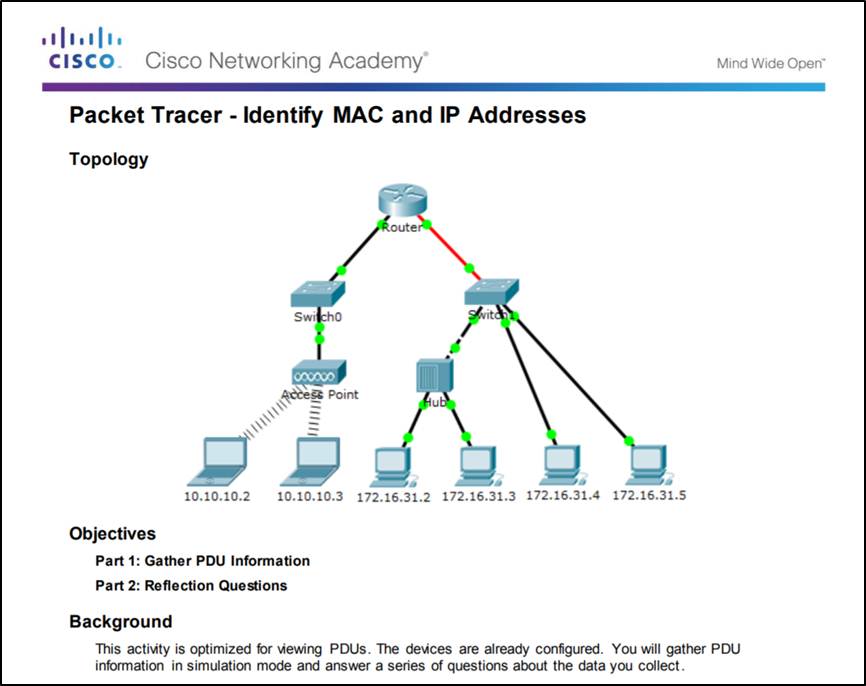
5.3.2 – ARP
5.3.2.1 – Introduction to ARP
When a device sends an Ethernet frame, it contains these two addresses:
♦ Destination MAC address
♦ Source MAC address
To determine the destination MAC address, the device uses ARP.
ARP provides two basic functions:
♦ Resolving IPv4 addresses to MAC addresses
♦ Maintaining a table of mappings
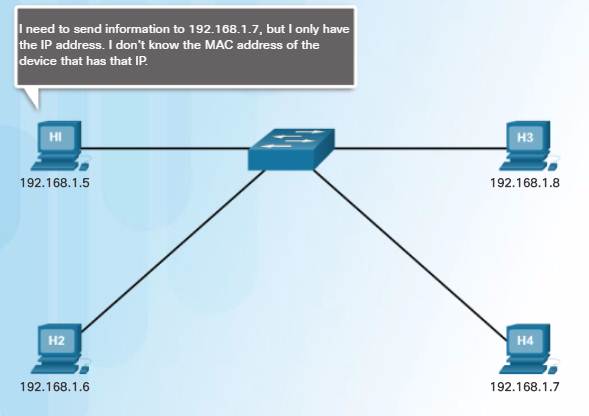
5.3.2.2 – ARP Functions
Ethernet devices refer to an ARP table (or the ARP cache) in its memory (i.e., RAM) to find the MAC address that is mapped to the IPv4 address.
A device will search its ARP table for a destination IPv4 address and a corresponding MAC address.
♦ If the packet’s destination IPv4 address is on the same network as the source IPv4 address, the device will search the ARP table for the destination IPv4 address.
♦ If the destination IPv4 address is on a different network than the source IPv4 address, the device will search the ARP table for the IPv4 address of the default gateway.
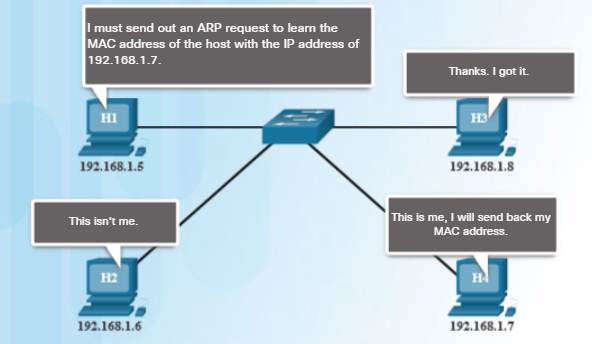
5.3.2.3 – Video Demonstration – ARP Request
An ARP request is a broadcast frame sent when a device needs a MAC address associated with an IPv4 address, and it does not have an entry for the IPv4 address in its ARP table.
ARP messages are encapsulated directly within an Ethernet frame. There is no IPv4 header.
The ARP request message includes:
♦ Target IPv4 address
♦ Target MAC address
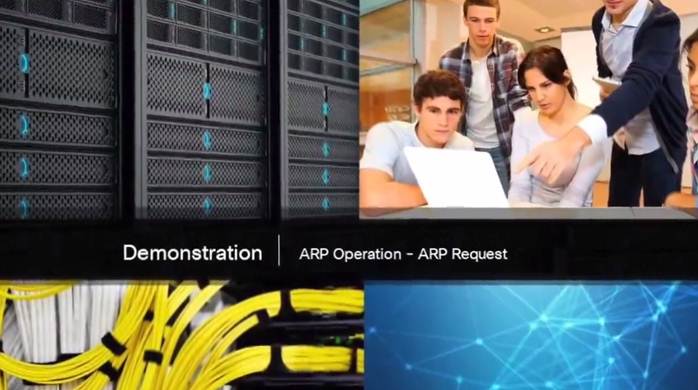
5.3.2.4 – Video Demonstration – ARP Reply
Only the device with an IPv4 address associated with the target IPv4 address in the ARP request will respond with an ARP reply.
The ARP reply message includes:
♦ Sender’s IPv4 address
♦ Sender’s MAC address
Entries in the ARP table are time stamped. If a device does not receive a frame from a particular device by the time the timestamp expires, the entry for this device is removed from the ARP table.
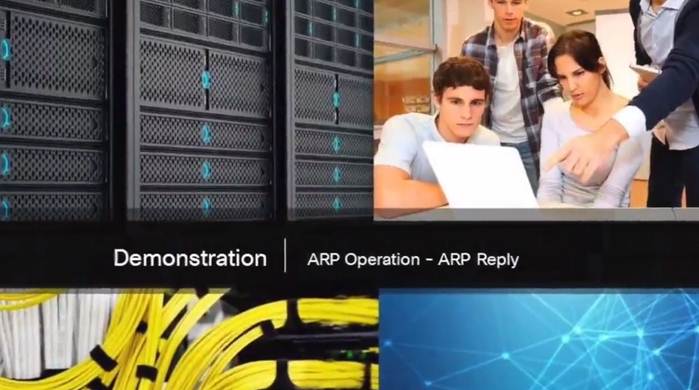
5.3.2.5 – Video Demonstration – ARP role in Remote Communications
When a host creates a packet for a destination, it compares the destination IPv4 address and its own IPv4 address to determine if the two IPv4 addresses are located on the same Layer 3 network.
If the destination host is not on its same network, the source checks its ARP table for an entry with the IPv4 address of the default gateway.
If there is not an entry, it uses the ARP process to determine a MAC address of the default gateway.
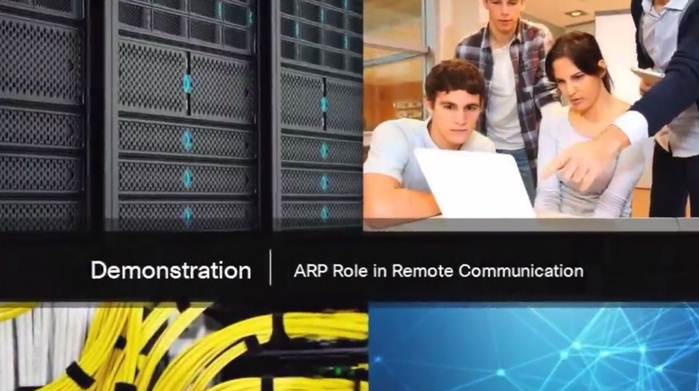
5.3.2.6 – Removing Entries from an ARP Table
Every device has an ARP cache timer that removes ARP entries that have not been used for a specified period of time.
The times differ depending on the device’s operating system. As shown in the figure, some Windows operating systems store ARP cache entries for 2 minutes.
You can also manually remove all or some of the entries in the ARP table.
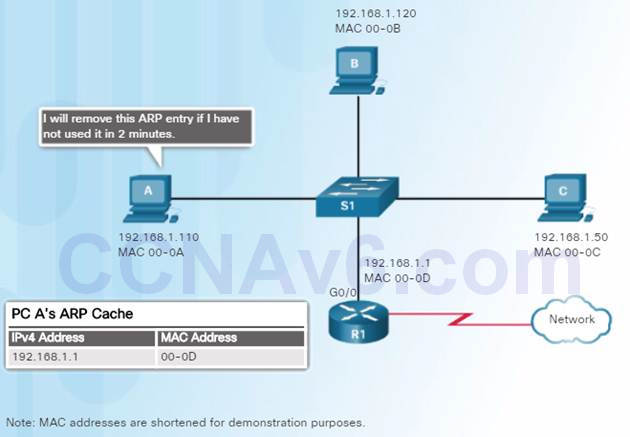
5.3.2.7 – ARP Tables
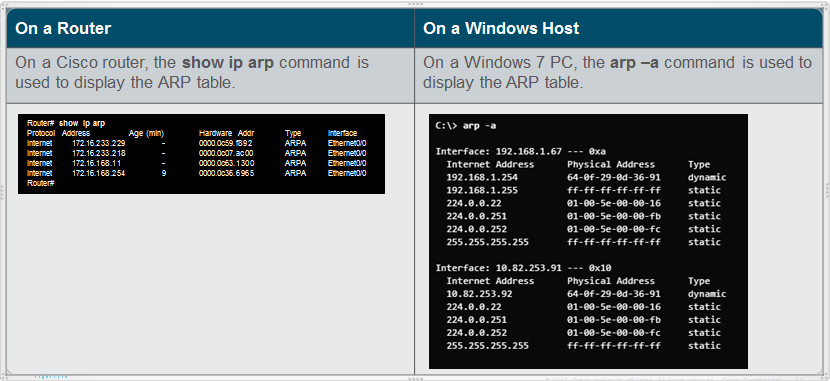
5.3.2.8 – Packet Tracer – Examine the ARP Table
5.3.2.8 Packet Tracer – Examine the ARP Table
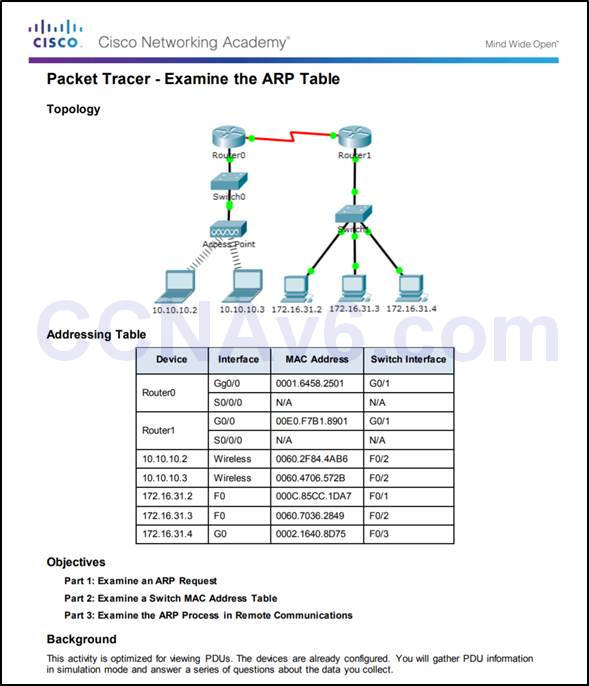
5.3.3 – ARP Issues
5.3.3.1 – ARP Broadcasts
As a broadcast frame, an ARP request is received and processed by every device on the local network.
ARP requests can flood the local segment if a large number of devices were to be powered up and all start accessing network services at the same time.
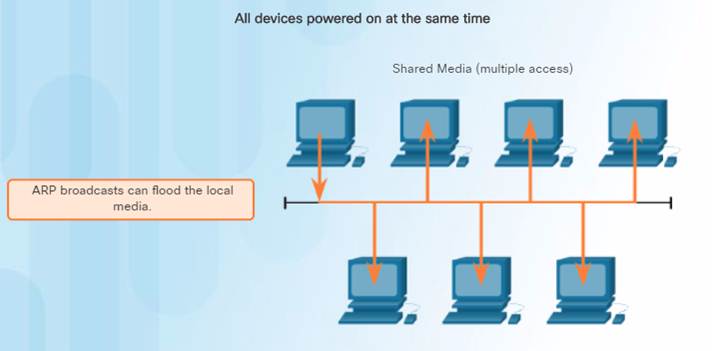
5.3.3.2 – ARP Spoofing
Attackers can respond to requests and pretend to be providers of services.
One type of ARP spoofing attack used by attackers is to reply to an ARP request for the default gateway. In the figure, host A requests the MAC address of the default gateway. Host C replies to the ARP request. Host A receives the reply and updates its ARP table. It now sends packets destined to the default gateway to the attacker host C.
Enterprise level switches include mitigation techniques known as dynamic ARP inspection (DAI).
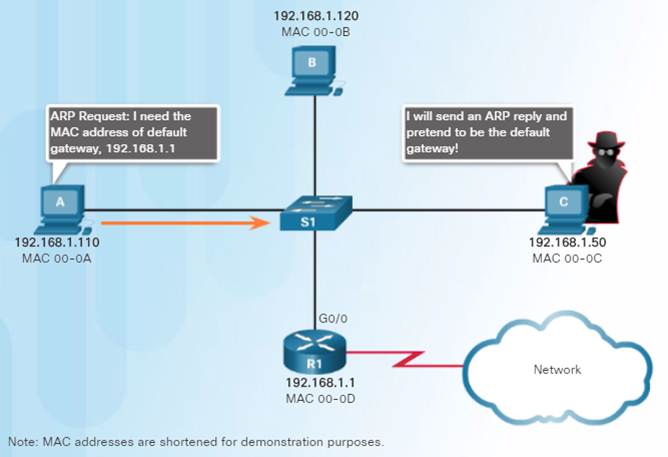
5.4 – Summary
5.4.1 – Conclusion
5.4.1.1 Class Activity – MAC and Choose
5.4.1.1 Class Activity – MAC and Choose
5.4.1.2 – Chapter 5: Ethernet
Explain the operation of Ethernet.
Explain how a switch operates.
Explain how the address resolution protocol enables communication on a network.
New Terms and Commands
Section 5.1
| •IEEE 802.2
•IEEE 802.3 •LLC Sublayer •MAC Sublayer •Data Encapsulation •Frame Delimiting •Cyclic Redundancy Check •Carrier Sense Multiple Access (CSMA) •Ethernet II •Frame Check Sequence (FCS) •Preamble •EtherType |
•Runt
•Collision Fragment •Jumbo •Baby Giant Frame •Hexadecimal •Organizationally Unique Identifier (OUI)
|
Section 5.2
| •burned-in address (BIA)
•ipconfig /all command •ifconfig command •Unicast MAC Address •Broadcast MAC Address •Multicast MAC Address •Content Addressable Memory (CAM) •Store-and-forward •Cut-through •Fast-forward switching •Fragment-free switching •Port-based Memory Buffering •Shared Memory Buffering |
•Half-duplex
•Full-duplex •Auto-MDIX •Address Resolution Protocol (ARP)
|
Section 5.3
- ARP Table
- ARP Cache
- ARP Request
- ARP Reply
- show ip arp, arp –a
- ARP spoofing
